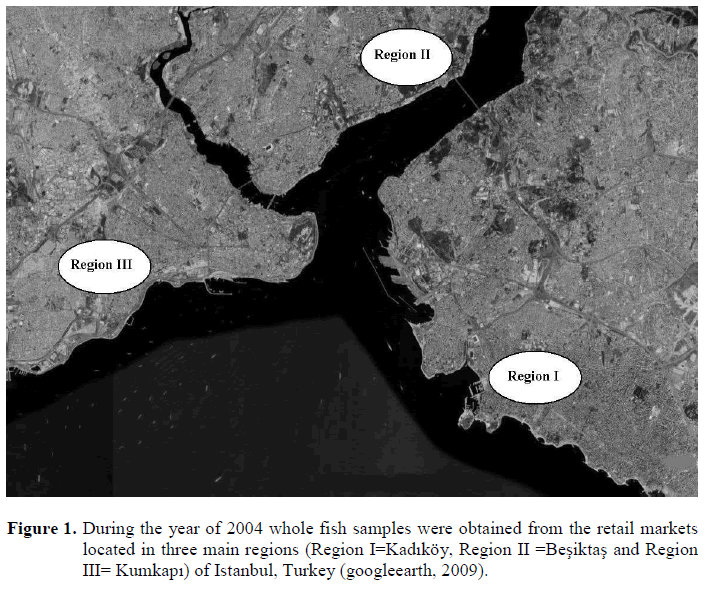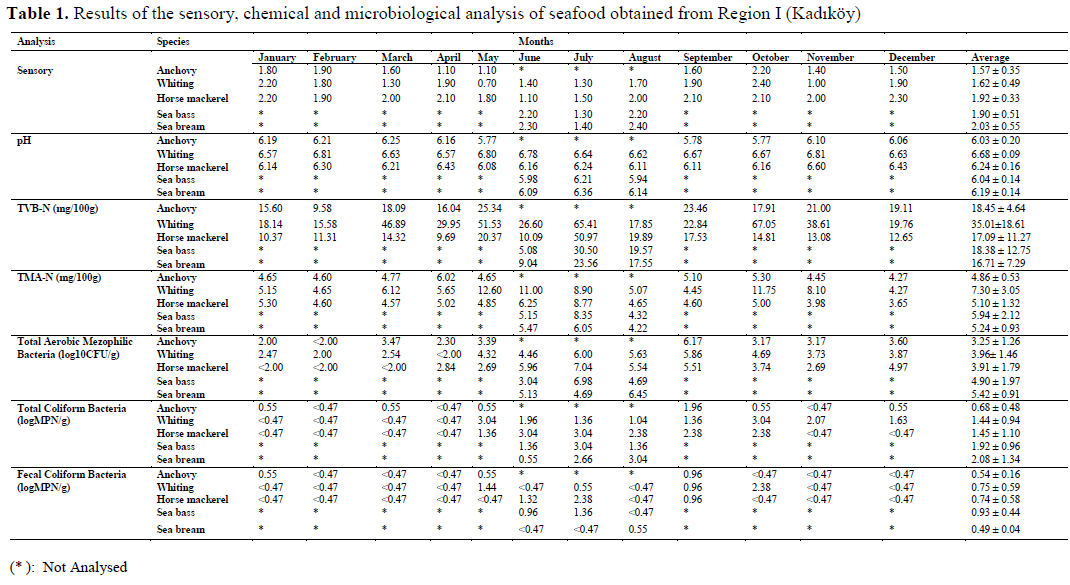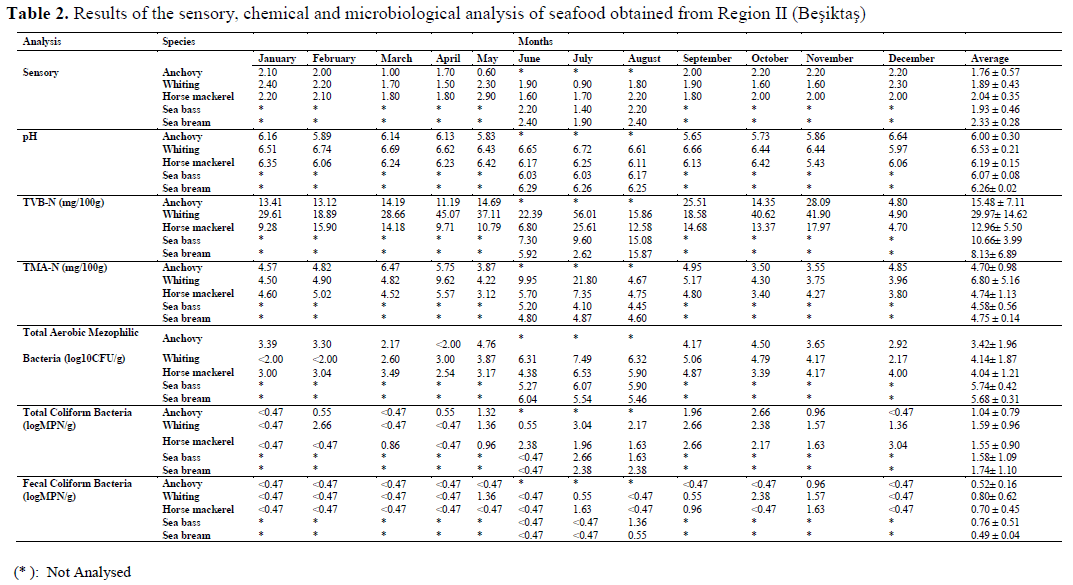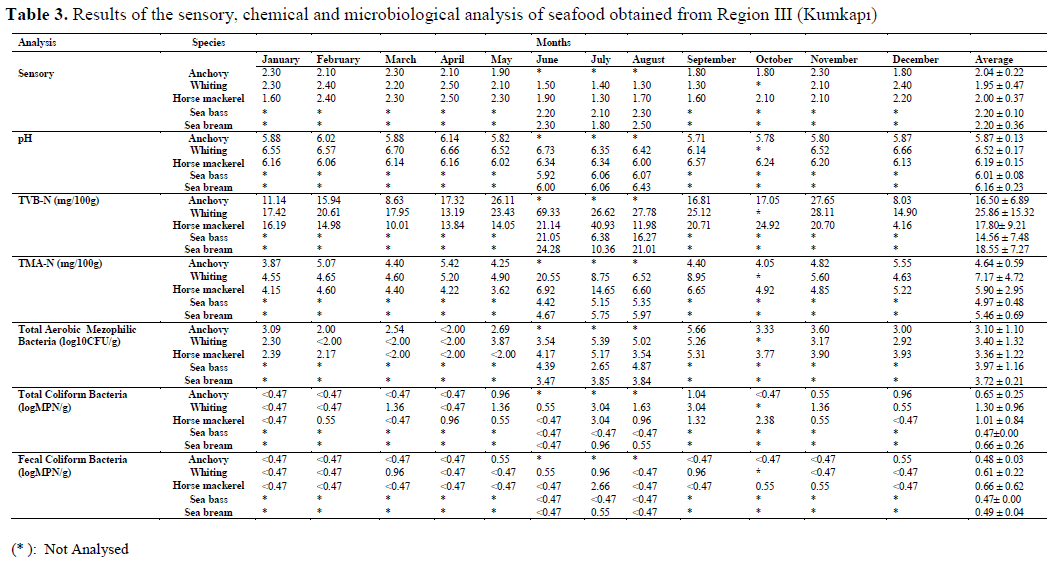Keywords
Seafood, Fish quality, Fish markets, Retail market
Introduction
Seafood is very important in human nutrition; but it might be contaminated after catching and/or transporting to the market. When seafood is contaminated, the microorganisms grow, spoi-lage starts, and consumption became dangerous. Maintenance of the sanitation in fish markets is necessary to prevent contamination (Sikorski et al., 1990).
There are many studies on the estimation of the safety and quality of seafoods from different regions of the world and these studies are very important to know health risks. Quality of smoked fish in Newfoundland-Canada (Dillon et al., 1994), retail fresh fish fillets in Netherlands (Broek et al., 1984), raw seafood products in Tokyo- Japan (Handa et al., 2005), fresh and cured fish in Cochin –India (Lalitha and Suren-dran, 2002), fish and crustaceans in Coimbatore-India (Hatha and Lakshmanaperumalsamy, 1997; Vivekanandhan, et al., 2005), smoked fish and fish pate in Spain (Dominguez et al., 2001), and retail fish products in Southern Finland (Johansson et al., 1999) were studied and health risks were evaluated.
Turkey is a peninsula and has many inland water resources. According to the official data; total amount of the marine and inland products are 582 376 tons. This country imports 44230 tons, and exports 14533 tons of seafood per year (Anon 2000). Istanbul is the major seafood sup-plier of Turkey, and also the main gate to export seafoods to Europe. However, there is a lack of information on the quality of commercial sea-foods in Istanbul. Therefore, the aim of this study is to provide the basic information about the quality and safety of them.
Materials and Methods
Anchovy (Engraulis encrasicolus), horse mackerel (Trachurus trachurus), whiting (Mer-langius merlangus), sea bass (Dicentrarchus la-brax) and sea bream (Spraus aurata), were ob-tained from the retail markets located in three main regions (Region I=Kadikoy, Region II =Besiktas and Region III= Kumkapi) of Istanbul. These regions were presented in Figure 1. It is possible to find horse mackerel and whiting in local markets during all year (whiting was not found in Region III retail market in October).

Figure 1: During the year of 2004 whole fish samples were obtained from the retail markets located in three main regions (Region I=Kadiköy, Region II =Besiktas and Region III= Kumkapi) of Istanbul, Turkey (googleearth, 2009).
However catching of anchovy, the most pop-ular fish in Turkey, is prohibited by the govern-ment in summer. Due to this prohibition; con-sumption of sea bream and sea bass is very com-mon in summer since they are intensively cul-tured species. Therefore; quality levels of sea bream and sea bass were studied in summer when it was not possible to study with anchovies. For each species of fish 2 kg of sample were analyzed per month.
They were iced in styrofoam boxes and trans-ferred to Istanbul University, Faculty of Fishe-ries, Seafood Processing and Quality Control La-boratory in 30 minutes. Sensory, chemical (pH, TVB-N (Total volatile basic nitrogen) and TMA-N (Trimethylaminenitrogen)) and microbiologi-cal (total mesophilic aerobic bacteria, total coli-form, fecal coliform and Salmonella sp.) analysis were carried out in order to the determination of the quality levels of fish.
Sensory analysis: Sensory properties were assessed by five judges. Firmness and smell of the flesh; and appearance of the skin, gills, eyes, flesh, and color of fish were regarded (Anon 1996). Three was the highest quality and the samples lower than 1.0 were considered spoiled.
pH analysis: Fish were homogenized and WTW InoLab pH meter (Germany) was used for the pH measurements (Manthey et al., 1988).
Biochemical analysis: The method of Schormüller (1968) was used for TVB-N and TMA-N estimations. The sample was boiled and the vapor components held with 0.1N Hydroch-loric acid was titrated with 0.1N sodium hydrox-ide and the TVB-N was expressed as mg/100g fish. For the estimation of TMA-N content of fish, samples were mixed with 10% trichloracetic acid solution and filtrated. Filtrate was well mixed with potassium hydroxide (50%), formal-dehyde (20%) and toluene. Upper layer was sepa-rated, mixed with picric acid (0.2%) and meas-ured by spectrophotometer at 450 nm (Shimatzu UV visible 1601, Japan). Results were compared with the standard curve and trimethylamine con-tent of the sample was expressed as mg/100g fish.
Microbiological analysis: 10 g of the sample was mixed with 90 ml of peptone water, homo-genized in a stomacher (IUL Instrument, Spain) and diluted with peptone water. Total mesophilic aerobic bacteria were determined using Plate Count Agar and plates were incubated for 24 hours at 35 °C (FDA 1984). Lauryl Sulfate Tryptose Broth tubes were inoculated and incu-bated 24-48 h at 37 °C to estimate the coliform bacteria. After that Brilliant Green %2 broth was used for the total coliform validity test. EC (Escherichia coli) Broth tubes were incubated at 44.5°C for 24 h for fecal coliform estimation. Gas producing tubes were evaluated according to MPN (most probable number) table (Baumgard, J. 1986).
In a sterilized jar, a tampon solution (225ml) was prepared with Phosphate Buffered Saline Tablets; samples (25g) were mixed in this solu-tion and incubated 16-20 h. at 37 °C to estimate Salmonella. Selenite Cysteine Broth and Tetra-thionate Broth were inoculated and incubated at 35-37 °C for 24 h and 18-24 h respectively for the selective enrichment. Bismuth Sulfite Agar and Xylose Lysine Desoxycholate Agar were in-oculated and incubated 24-48 h at 37 °C as se-lective agar. Two different slant agars (Triple Sugar Iron Agar and Lysin Iron Agar) were used for identification and Salmonella sp. was eva-luated as negative or positive (Andrews, 1992).
Statistical analysis: Statistical differences were studied on the probability P<0.05, ANOVA was performed to compare the means (Sümbüloglu and Sümbüloglu,. 2002) and Excel 1997 was used.
Results and Discussion
Sensory, chemical and microbiological analy-sis of fish (anchovy, horse mackerel, whiting, sea bass and sea bream), obtained form the retail markets located in three main regions of Istanbul, were presented in table 1, 2 and 3.

Table 1: Results of the sensory, chemical and microbiological analysis of seafood obtained from Region I (Kadiköy)

Table 2: Results of the sensory, chemical and microbiological analysis of seafood obtained from Region II (Besiktas)

Table 3: Results of the sensory, chemical and microbiological analysis of seafood obtained from Region III (Kumkapi)
In this study the average pH values of the anchovies obtained from Region I, Region II, and Region III were 6.06, 6.00 and 5.87 respectively. Baygar and Özden (2004) reported pH value for anchovies as 6.21. In another study the average pH values of anchovies were regarded as 6.08 in fall, 6.15 in winter, and 6.20 in spring (Türker et al., 1999). The results are similar to that of ours study. The average pH value of horse mackerels obtained from Region I was 6.24, and it was 6.19 for the samples obtained from the other regions of Istanbul. Özden and Baygar (2003) obtained horse mackerels from the markets in Istanbul and reported the pH the value as 6.04. In another study, the pH value of Trachurus murphy selling in Valdivia, Chile was 6.29 (Schoebitz et al., 1985). It was mentioned that, pH values of the fresh fish are between 6.00 and 6.50, the limit of acceptability is between 6.80-7.00 (Baygar, et al., 2002; Connell, 1980; Inal, 1992). In our study pH values were lower than 7.00 for all samples and they were in acceptable quality.
Fish and fish products were accepted as “very good” when they contain 25.00 mg/100g or lower TVB-N values; “good” when contain 30.00 mg/100g TVB-N; “marketable’ when contain 35.00 mg/100g TVB-N and “spoiled” over 35.00 mg/100g TVB-N values (Kietzman et al. 1969). In this study, the average TVB-N values of whiting samples were higher (P<0.05) than other species in all sampling regions and the other spe-cies were in “very good” quality according to the mean TVB-N values of catching season. In vari-ous studies total volatile basic nitrogen content of anchovies obtained from the retailers in Istanbul was not reported higher than 20 mg/100g. (Özden, and Baygar, 2003; Perk, 1995; Varlik et al., 2000) and they were regarded as fresh. In this study it was determined that TVB-N values of anchovies higher (P<0.05) in may, and fall due to the high ambient temperature (32 ±2°C) Similarly, Turker et al. (1999) (Türker et al.,1999) reported TVB-N values of anchovies as 17.82 mg/100g, 13.24 mg/100g and 13.09 mg/100g in fall, winter and spring seasons re-spectively. It was determined that, the average TVB-N values of anchovy and whiting from Re-gion I was significantly higher (P<0.05) then the others. Even if the TVB-N content of the sea bass obtained from Region I was significantly higher (P<0.05) in July (30.50 mg/100g), sea bass sam-ples were acceptable during the study. European Union (1995), accepted the TVB-N limit for sea bream as 25.00 mg/100g. Therefore it is clear that sea breams were acceptable during the study.
Fish and other seafoods were accepted as “good” when they contain 4.00 mg/100g TMA-N; “marketable” when they contain 10.00 mg/100g TMA-N, and they accepted as “spoiled” when they contain 12.00 mg/100g TMA-N (Con-nell, 1980). In this study, the average TMA-N values were lower than 10.00 mg/100g for all samples. However; TMA-N content of whiting which were obtained from Region I was over 12.00 mg/100g in May; and these samples were “unmarketable”. For whiting samples which were taken from Region II, TMA-N value was very high in July and they were also “unmarketable”. Trimethylamine nitrogen values of the samples obtained from Region III showed that, whiting samples were unmarketable in June and horse mackerels in July. These values were higher (P<0.05) than the others. It is clear that; TMA-N content could be over the limits especially in summer season due to the high ambient temper-atures.
The limit value for total mesophilic aerobic bacteria for seafood is 106 CFU/g (6.00 log CFU/g) (Anon 1992). This limit is accepted as 5.00x105 CFU/g (5.69 log CFU/g) by ICMFS (1986). The average values were remained be-low these limits, but as it was shown in Table 1 and 2, samples obtained from the retailers in Re-gion I and II excess these limits especially be-tween June-August. However total mesophilic aerobic bacteria counts of the samples obtained from Region III (Table 3) remained lower (P<0.05). In a similar study 78% of the samples were unacceptable in terms of microbiological quality and in Finnish retail market. It was con-cluded that, the hygienic quality of fish roes in Finnish retail market should be improved (Miettinen et al., 2003).
The limit value for the total coliform bacteria is 160-210 MPN/g (2.20-2.32 log MPN/g) (Anon 1992). According to the average total and fecal coliform bacteria counts; the samples obtained from Region III were in better quality (P<0.05) than the samples obtained from the other regions of Istanbul. The average fecal coliform values were lower than 1.0 log MPN/g during the study. Similarly, microbiological quality of Trachurus sp. sold at the retail level in Valdivia – Chile was reported to have fecal coliforms as 0.72 log MPN/g (Schoebitz et al., 1985).
European Union prohibits the trade of seafood containing Salmonella sp. and raw seafood must not contain it (Anon 1992; Huss et al., 2003). The prevalence of Salmonella in fish from markets in Coimbatore, South India was studied. Samples were found to be contaminated (14.25%) with Salmonella sp (Hatha and Laksh-manaperumalsamy, 1997). However; in this study all the samples were found as free of Salmonella sp. similar to Schoebitz et al. (1985).
Conclusion
It was concluded that quality of the samples were lower during summer season due to the high ambient temperatures (32 ±2 ºC) and the quality of fish selling in Region III, where whole-sale fish market also located in, was generally better than far-distance regions (Regions I and II). Therefore it was concluded that; unsuitable transport conditions of seafood from whole sale market to the retailers are the main reasons of de-creasing quality. Refrigerated transport and temperature control are very important especially in summer season regarding the high ambient temperatures. The regulation of Turkish government (Anon 2002), which is harmonious with EC crite-ria must be strictly followed to avoid secondary contamination and to maintain the safe trade of seafoods from in to Europe.
Acknowledgements
This work was supported by the Research Found of Istanbul University. Project Number: T-127/11112002.
824
References
- Andrews, W., (1992). Manuals of Food Quality Control, 4. Microbiological Analysis, FAO, Rome
- nAnon, (1996). Laying down common marketing satandarts for certain fishery products. EC Concil reglation N 2406/96
- nAnon, (2000). Su Ürünleri Istatistikleri. Türkiye Cumhuriyeti Basbakanlik Devlet Istatistik Enstitüsü Basimevi, Ankara
- nAnon, (2002). Su Ürünleri Toptan ve Perakende Satis Yerleri Yönetmeligi. 19.06.2002 tarih ve 24790 sayili resmi gazete. T.C. Tarim ve Köyisleri Bakanligi Koruma Kontrol Genel Müdürlügü, Ankara
- nBaumgard, J., (1986). Lebensmittel tierischer Herkunft, Feinkosterzeugnisse, gefrorene, tiefgefrorene und getrocknete lebensmittel, Fertiggerichte, hitzekonservierte Lebensmittel, Speiseeis, Zucker, Kakao, Zuckerwaren, Rohmassen. Mikrobiologische Untersuchung von Lebensmitteln. Jürgen Baumgart, unter Mitarbeit von Jürgen Firnhaber, Gottfried Spicher (ed) Behr’s Verlag Hamburg
- nBaygar, T., Özden, Ö., (2004). Dondurma ve Çözündürme Isleminin Balik Kalitesi Üze-rine Etkisi, Turkish Journal of Veterinary and Animal Science, 28 (1):173-178
- nBaygar, T., Erkan,N., Metin, S, Özden, Ö., Varlik, C., (2002). Sogukta Depolanan Alabalik Dolmasinin raf Ömrünün belirlenmesi, Turkish Journal of Veterinary and Animal Science, 26(3): 577-580
- nBroek, M.J.M., Mossel, D.A.A., Mol, H., (1984). Microbiological Quality of Retail Fresh Fish Fillets in the Natherlands, Food Microbiology, 1(2): 53-61. doi:10.1016/0168-1605(84)90008-4
- nConnell, J.J., (1980). Control of Fish Quality 2nd ed., Fishing New Books Ltd., UK: Farnham
- nDillon, R., Patel, T., Ratnam, S., (1994). Occur-rence of Listeria in Hot and Cold Smoked Seafood Products, Inernational Journal of Food Microbiology, 22(1): 73-77. doi:10.1016/0168-1605(94)90009-4
- nDominguez, C., Gamez, I., Zumalacarregur, J., (2001). Prevalence and contamination levels of Listeria monocytogenes in smoked fish and pate sold in Spain, Journal of Food Protection, 64(12): 2075-2077
- nEuropean Union, (1995). Commission Decision 95/149/ EC of 8 March 1995 fixing the total volatile basic nitrogen (TVB-N) limit values for certain categories of fishery products and specifying the analysis methods to be used, Official Journal, L097: 84-87
- nFDA, (1984). Bacteriological Analytical Manual, 6th Edition, Ch.4 and 5. AOAC, Arlington, VA
- nHanda, S., Kimura, B., Takahashi, H., Koda, T., Hisa, K., Fujii, T., (2005). Incidence of Lis-teria monocytogenes in Raw Seafood Prod-ucts in Japanese Retail Stores, Jorunal of Food Protection, 68(2): 411-415
- nHatha, A.A.M., Lakshmanaperumalsamy, P., (1997). Prevalance of Salmonella in Fish and Crustaceans from Markets in Coimba-tore, South India, Food Microbiology, 14(2): 111-116. doi:10.1006/fmic.1996.0070
- nHuss, H.H., (1988). Fresh Fish Quality and Quality Changes, FAO Fisheries Series, vol. 29, FAO, Rome
- nHuss, H. H., Ababouch, L., Gram, L., (2003). As-sessment and Management of Seafood Safety and Quality. FAO Fisheries Tech-nical Paper 444
- nICMSF, (1986). International Commission on Microbiological Spesifictions for Foods, Sampling Plans for fish and Shellfish. In: ICMSF, Microorganisms in Foods. Sampling for Microbiological Analysis: Principles and Sciencetific Applications, 2nd Edition Vol 2, University of Toronto Press, Toronto
- nInal, T., (1992). Besin Hijyeni. Final ofset A. S., Istanbul, Türkiye, pp. 345-592
- nJohansson, T., Rantala, L., Palmu, L., Honkanen-Buzalski, T., (1999). Occurrence and Typing of Listeria monocytogenes Strains in Retail vacuum-packed Fish Products and in a Pro-duction Plant, International Journal of Food Microbiology, 47(1): 111-119. doi:10.1016/S0168-1605(99)00019-7
- nKietzman, U., Priebbe, K., Rakow, D., Reichstein, K., (1969). Seefisch als Lebensmittel. Paul Parey Verlag, Hamburg-Berlin., pp. 176-368
- nLalitha, K.V., Surendran, P.K. (2002). Occurrence of Clostridium botulinum in fresh and cured fish in retail trade in Cochin (India), International Journal of Food Microbiology, 72(1): 169-174. doi:10.1016/S0168-1605(01)00632-8
- nLang, K., (1979). Der Flüchtige Basenstichstoff (TVB-N) bei im Binnenland in der Verkehr gebracheten frichen seefischen, Archiev für Lebensmittelhygiene, 30: 215-217
- nLang, K., (1983), Der Flüchtige Basenstichstoff (TVB-N) bei im Binnenland in der Verkehr gebracheten frichen seefischen, Archiev für Lebensmittelhygiene, 34: 7-10
- nManthey, M., Karnop, G., Rehbein, H., (1988). Quality Changes of European Catfish (Silurus glanis) from Warm- Water Aquaculture During Storage Ice, International Journal of Food Science and Technology, 23(1): 1-9. doi:10.1111/j.1365-2621.1988.tb00543.x
- nMiettinen, H., Arvola, A., Luoam, T., Wirtanen, G., (2003). Prevalance of Listeria monocytogenes and Microbiological and Sensory Quality of Rainbow Trout, Whitefish, and Vendace Roes from Finnish Retail Markets, Journal of Food Protection, 66(10): 1832-1839
- nÖzden, Ö., Baygar, T., (2003). Farkli Paketleme Yöntemlerinin Marine Edilmis Bazi Baliklarin Kalite Kriterleri Üzerine Etkisi, Turkish Journal of Veterinary and Animal Science, 27(4): 899-906
- nPerk, E., (1995). Farkli Cins Baliklarin Tazelik Kriterlerinin Incelenmesi, Istanbul Üniversitesi Fen Bilimleri Enstitüsü Yüksek Lisans Tezi, Istanbul
- nRenner, E., (1970). Mathematisch-Statitische Methoden in der Praktischen Anwendung. Verlag Paul Parey, Berlin Und Hamburg, pp. 9-90
- nSchoebitz, R., Tamayo, R., Davis M., (1985). Microbiological quality of the fish species Trachurus murphyi, sold at the retail level in the town of Valdivia, Chile, Food Microbiology, 2(4): 243-247. doi:10.1016/0740-0020(85)90004-8
- nSchormuller, J., (1968). Handbuch der Lebensmittelchemie. Springer-Verlag. Berlin- Heidelberg-New York, pp. 1341-1397, 1584-1585
- nSikorski, Z.E., Kolakowska, A., Burt, J.R., (1990). Postharvest Biochemical and Micro-bial Changes. In: Seafood: Resources Nutri-tional Composition and Preservation, Si-korski, Z.E (chief ed.), CRC Press Inc, USA: Florida, pp. 55-77
- nSümbüloglu K., Sümbüloglu V., (2002), Biyoistatistik. Hatipoglu Basim ve Yayim San. Tic. Ltd. Sti. Ankara
- nTürker, S., Gökoglu, N., Özden, Ö., Ekan, N., Metin, S., Baygar, T., (1999). Avlanma mevsiminin Hamsi (Engraulis engrasicolus, Lin. 1758) Baliginda Bazi Kalite Degerle-rine ve Dayanma Süresine Etkisi, Biyoteknoloji (KÜKEM) Dergisi, 22(2): 41-48
- nVarlik, C., Erkan, N., Metin, S., Baygar, T., Öz-den, Ö., (2000). Marine Balik Köftesinin Raf Ömrünün Belirlenmesi, Turkish Journal of Veterinary and Animal Science, 24(6): 593-597
- nVivekanandhan, G., Hatha, A.A.M., Lakshmana-perumalsamy, P., (2005). Prevalance of Aeromonas hydrophila in fish and Prawns from the Seafood Market of Coimbatore, South India, Food Microbiology, 22: 133-137. doi:10.1016/j.fm.2004.01.015










